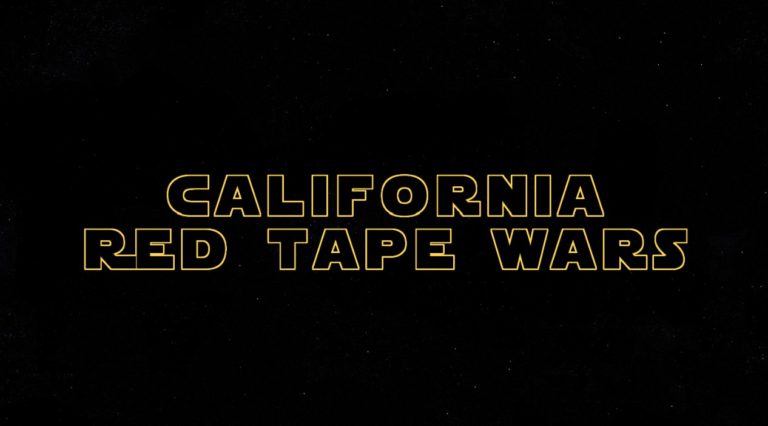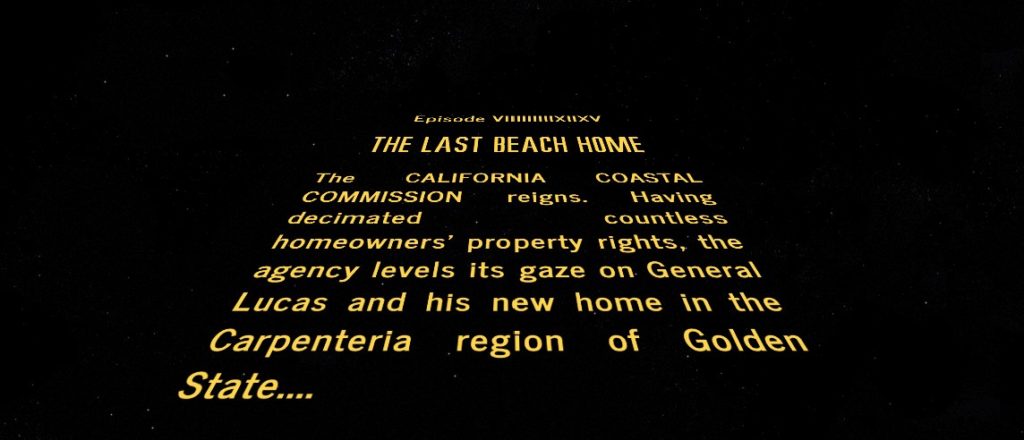George Lucas just bought a new California beach home, here’s all the red tape he (and any California homeowner) faces

Filmmaker and sci-fi deity George Lucas recently purchased a $28 million, 2-acre plot of California beachfront land in the city of Carpinteria. Lucas’ new land is next door to his existing home in Carpinteria and expands his beachfront property to just under 4 acres.
The Star Wars creator hasn’t announced what he plans to do with the new property or how he plans on combining it with his existing home, but since California bureaucracy can be harder to understand than a Jar Jar Binks poetry slam, I asked some of the property rights and land use experts at Pacific Legal Foundation just how much red tape and bureaucracy Lucas (or any California homeowner near the coast) would face to accomplish some standard renovation and improvement projects.
Unfortunately for Golden State homeowners, California government can be harder to deal with than a Wookiee in a barber shop.

Pictures of Lucas’ existing and new properties show many trees dividing the two plots of land. Since Lucas is combining two plots, he might want to remove some of the foliage in between the houses. To do this he would need to:
- Obtain a county permit from Santa Barbara if the trees are in the front yard or are heritage trees.
- If he plans on replanting any of the trees, he might need to obtain water use and well permits if the existing water supply is inadequate.
Star Wars has shaped so much of our pop culture. That means Lucas has a lot of fans who would like to see the creator up close, so he might want to build a fence around his property for some privacy and security.
- If he’s building a new fence, he would probably need to obtain a coastal development permit from the city.
- Coastal development permits might sound innocuous, but depending on the project (or the mood of the employee processing the paperwork) they can be quite a process:
- Once the application is submitted, staff will review and make recommendations, including any mitigation measures (fees) needed.
- Then there will be a public hearing.
- If there are no objections, the permit will be forwarded to the California Coastal Commission (CCC).
- If CCC staff have objections, they will ask a commissioner to file an appeal.
- The CCC appeal coincidentally goes to the CCC.
- After receiving the appeal from themselves, the CCC will ask CCC staff for recommendations and they will schedule another public hearing.
- At the hearing, people can testify for and against the application. Then the CCC will vote the project up or down.
- After the vote, the losing side may file an appeal which will go to court.
- The court will then decide whether the permit is legal or whether more environmental studies (that the homeowner would pay for) are needed.
- After the court case is settled, the application process will start over.
- In Carpinteria, if the fence is over six feet in the back or three feet in the front, Lucas would need a fence permit and would need to go before the city’s architectural review board for approval.
- If he repairs an existing fence, then no permit is required…but only if he can prove the fence was there before the California Coastal Act was adopted in 1976. If Lucas can’t prove that the fence was there before 1976, then he’ll need to obtain a coastal development permit to do anything at all to it.
- Coastal development permits might sound innocuous, but depending on the project (or the mood of the employee processing the paperwork) they can be quite a process:
Carpinteria is known for its beautiful beaches, so Lucas might like to add on a deck, patio, or gazebo to enjoy his view. What are the regulatory requirements for those?
- Depending on where he wants to build, and depending on if the State Lands Commission thinks he is trying to build on state-owned land, he might need to prove that the beach is actually privately owned. In California, many times buying the beach isn’t enough. You need to buy the beach, then prove that the beach you just bought is now privately owned…by you.
- If he can prove that he owns the beach he just bought, then he will need a Coastal Development permit (see above) to put anything on the beach (e.g., gazebo, walkway, Millennium Falcon landing pad, etc.).
- If he plans to build anything below the mean high tide line, he would need to go through all the permitting processes with state and local governments, which could result in a challenge from the State Lands Commission.
If Lucas wanted to set off a few celebratory fireworks on the anniversary of the Battle of Yavin (or on the fourth of July) he would need to:
- Obtain a coastal development permit (again, see above). California considers anything that has a gaseous emission (smoke) to be a physical “development” on the beach. PLF represented the California city of Gualala in a lawsuit in 2010 where the CCC prevented the city from setting off Fourth of July fireworks because the CCC thought that the noise from the fireworks would disturb nearby birds (seriously).
Finally, the new land that Lucas bought includes a small Cape Cod-style house, a guesthouse, a tree house, and a barn. Lucas’ existing land already has a spacious home so he might want to expand his current house or build a new home on his now-combined property.
- If he is only building up and not expanding the house outward then he will need to:
- Obtain building permits and a coastal development permit from the city or county.
- Pay the city a mitigation fee for any impacts caused by the project. In some jurisdictions, this might include impacts the remodel has on the public’s view of the ocean.
- If he adds any bedrooms, he may need to pay a mitigation fee to the city and/or county for increased traffic to the area (for the constant stream of new house guests Lucas will host in his extra bedroom). He may also need to pay a mitigation fee to the local school district for the new school facilities they would be required to build (to accommodate all the new children that Lucas, 75, might be sending to school as a result of adding one extra bedroom).
- Lucas will also likely have to pay the local water district a mitigation fee for any increased water usage.
- If Lucas wanted to expand the home’s footprint—that is, build out instead of up—in addition to all the permits and fees above, he would potentially need to:
- Pay for state impact studies to determine if expanding the house would have any impact on endangered species or natural area vegetation. The first study would be an environmental assessment to determine if the expanded home’s footprint would have any impact on the nearby human environment. If that study shows an impact on the human environment then Lucas would have to have an environmental impact report done.
- If he changes the home’s grading (slope of the land), he would need to get a grading permit, which could be subject to the CCC’s approval depending on how the local zoning ordinances are written.
Property owners in California must constantly deal with a maddening labyrinth of state bureaucracy. In a state where farmers have literally been fined millions of dollars for plowing dirt in their field, property owners face daunting, and expensive, battles with regulators and bureaucrats to do even the simplest thing on their own property.
George Lucas has the resources to deal with the absurd government regulations and requirements for working on his land, but not every California property owner can afford the costs that come with California’s bureaucratic nightmare. Unfortunately, many California property owners have been forced to take California regulators to court to defend their property rights.
PLF has won many battles against California’s constant affront on homeowners’ property rights and even silly examples like these are why we will continue to fight. So may the force be with you, California homeowners. When it comes to the state government, we all need it.






